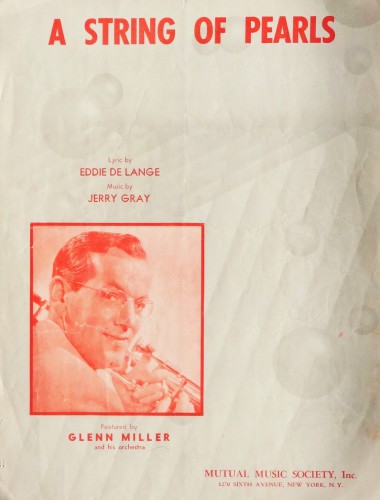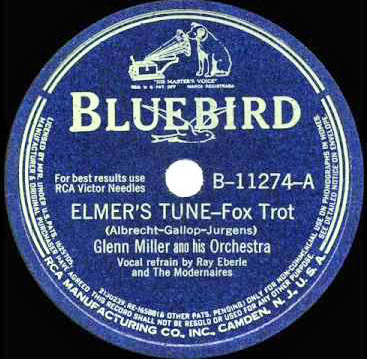Mickey McMickle, Johnny Best, Zeke Zarchy, Billy May (tp); Glenn Miller, Paul Tanner, Jimmy Priddy, Frank D’Annolfo (tb); Skip Martin, Wilbur Schwartz, Ernie Caceres, Tex Beneke, Al Klink (reeds); Chummy MacGregor (p); Bobby Hackett (g & cornet); Doc Goldberg (b); Maurice Purtill (d); Marion Hutton, Ray Eberle, Tex Beneke, The Modernaires (vcl); Bill Finegan, Jerry Gray, Billy May (arr).
RCA Victor Studios, New York – November 24, 1941, 12:00-6:00 PM
068418-1 Moonlight Sonata (BF arr) Bluebird 11386-A
068419-1 Slumber Song (BF arr) Bluebird 11386-B
068420-1 The White Cliffs of Dover (RE vcl, JG arr) Bluebird 11397-A
068421-1 We’re the Couple in the Castle (RE vcl, BF arr) Bluebird 11397-B
068422-1 It Happened in Hawaii (RE & M vcl, JG arr) Bluebird 11416-B
It was an all-ballad studio session for the Glenn Miller band on November 24, 1941. By this time, the experimental placement of Tex Beneke on alto sax lead had ended and he returned to his usual place in the reed section on tenor. New tenor addition Babe Russin left and Skip Martin joined as the new alto lead. Bobby Hackett kept his guitar position, with occasional cornet solos and Zeke Zarchy was added to the trumpets. With only slight changes, this personnel would remain in place for awhile.
The first selection waxed was a rare feature for pianist Chummy MacGregor, on Bill Finegan’s arrangement of MOONLIGHT SONATA. This lovely setting of the main theme of Beethoven’s Piano Sonata No. 14 in C-Sharp Minor, Opus 27, No. 2 is mostly a fantasia for reeds and piano. Beneke, the only soloist heard on this session, gets a brief spot. It’s also one of Glenn’s longest Bluebird sides, squeezing 3 minutes and 35 seconds onto the disc.
As an appropriate B-side, Miller finally set down his BMI radio theme song, SLUMBER SONG, which he had been using since October 1940, as an alternate to MOONLIGHT SERENADE. Though by now the ASCAP radio war was settled, Glenn continued to use SLUMBER SONG as his closing theme. It’s a suitably wistful melody, again arranged by Finegan, credited to Chummy MacGregor and lyricist Saul Tepper. Tepper was an advertising illustrator, who moonlighted as a songwriter, this being his best-known number. The Modernaires are tossed in for a soothing humming passage. Chummy gets label credit on both sides of Bluebird 11386!
Comes next another big Miller hit, (THERE’LL BE BLUE BIRDS OVER) THE WHITE CLIFFS OF DOVER. The title was inspired by Alice Duer Miller’s Anglocentric 1940 novel, The White Cliffs. By the time the book was filmed in 1944 (with Irene Dunne and Van Johnson), the song had been such an overwhelming success that the movie title was revised to The White Cliffs of Dover. The film was hugely successful as well.
Intended to boost Anglo-American relations, this paean to British topography was totally an American product, by Nat Burton and Walter Kent (writers of WHEN THE ROSES BLOOM AGAIN and I’LL BE HOME FOR CHRISTMAS).
UK songstress Vera Lynn boosted it into one of the most anthemic of World War II songs. Glenn’s record, with a sympathetic Jerry Gray arrangement and a sensitive Eberle vocal, was pretty iconic on this side of the Atlantic. However, Burton and Kent should have checked an avian atlas, as Bluebirds are not to be found in Europe (except on RCA Victor records!).
Back in 1939, Glenn recorded two fine songs from the Paramount-Max Fleischer cartoon feature Gulliver’s Travels, by Leo Robin and Ralph Rainger. Now, the Fleischers’ second full-length animated effort, Mr. Bug Goes to Town, was about to be released. Top songwriters Hoagy Carmichael and Frank Loesser wrote the score this time, with the plug song being WE’RE THE COUPLE IN THE CASTLE.
Unfortunately, both the film and the song flopped big time. What with the war coming, were customers not in the mood for animated features like this and Dumbo? Did the subject of urban bugs turn people off? Was it simply a bad film?
Mr. Bug is no Dumbo, but it is a charmer in its own way. A later re-release, under the non-insect title Hoppity Goes to Town, was also unsuccessful and that failure pushed the Fleischers along the road to bankruptcy. Hoppity got an early sale to television and became a kiddie small-screen staple.
WE’RE THE COUPLE IN THE CASTLE is a pleasant enough song on its own and Bill Finegan does a fine job Millerizing it, with Ray effortlessly handling the lyrics.
IT HAPPENED IN HAWAII (here pronounced Hawaii-uh) now carries an ominous quality that wasn’t apparent in November 1941. By the time the record was released, the events of December 7th would, one would think, cause the song to be avoided. That apparently wasn’t the case, as both the Miller and Jimmy Dorsey-Bob Eberly-Helen O’Connell records were popular enough to receive 78 reissues in 1947. Go figure!
The song, by Mabel Wayne, who had a hit with the similarly titled IT HAPPENED IN MONTEREY, is, as expected, flavored with island exotica and a moody lyric by veteran Al Dubin. Ray and the Modernaires languorously float by on the waves of melody.
By the time the Glenn Miller Orchestra returned to the studio on December 8th, their world would be completely and shockingly upended.

























































